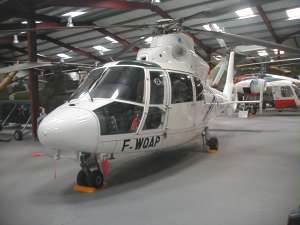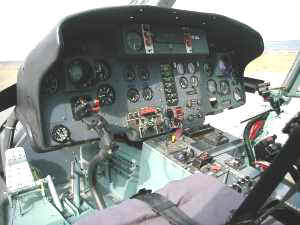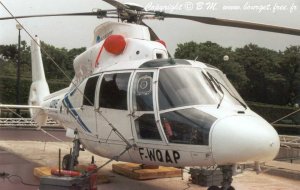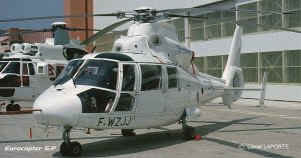Aérospatiale SA365N Dauphin 2, F-WQAP
 |
||
Eurocopter has donated an example of one of the world's more widely-used turbine aircraft, the Model SA365N Dauphin 2, F-WQAP, powered by two 710shp Turbomeca Arriel 1C turboshaft engines, to The Helicopter Museum. On 2nd April 2003 a low-loader arrived at The Museum carrying the helicopter after a 5-day journey from its former home at Eurocopter's Marignane headquarters in France. It was unloaded by crane and is now on display in the main Exhibition Hangar. This version of the Dauphin family is fitted with retractable, tricycle, landing gear, a composite rotorhead and a longer cabin, while retaining the characteristic, noise-reducing, Fenestron ducted tail rotor. |
||
 |
 |
|
| On 5th April 2003, three days after its delivery to The Museum, F-WQAP (above left) had the four main rotor blades bolted to the rotor head, the top of the rudder attached, and the stabilator (all-moving horizontal stabiliser), re-installed with its twin fins. Above right is a view of F-WQAP's instrument panel. | ||
F-WQAP began life as F-WZJJ,
c/n 6001, and was Aérospatiale's first production SA365N,
Dauphin 2, built at Marignane and making its first flight on 19th
December 1979. Twenty-seven years later the three records still stand. The previous records had been set up, exactly one month earlier, by Bristow Helicopters' Sikorsky S-76A, G-BHBF. The flights were intended, not only to achieve the speed records but also to demonstrate the possibilities of high speed passenger travel, by helicopter, between city centres. |
||
|
||
After setting up its speed records the Dauphin was used for a series of certification tests including hot and cold weather trials. In 1989 F-WZJJ was modified, at Aérospatiale's facility
at Marignane, near Marseilles, to allow the evaluation and demonstration
of a fly-by-wire system which, in 1990, also involved trials of
a lateral sidestick control for the right hand seat, additional
to the computers, electronic connections and actuators. Experience
gained with F-WZJJ led to later FBW implementation, by Eurocopter,
in NH Industries' multirole NH90, the first FBW helicopter to
go into production. |
||
 |
 |
|
Two views of F-WQAP at the Palais de Chaillot in 2001. Photographs © Benoit Marembert. |
||
